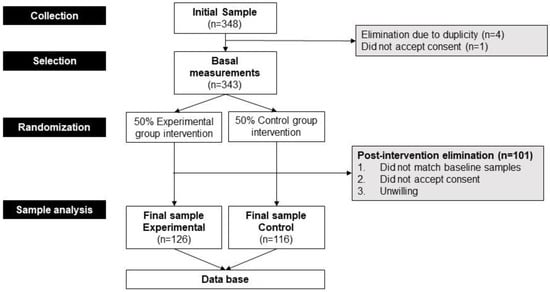Journal Description
Obesities
Obesities
is an international, peer-reviewed, open access journal on all aspects of obesity published quarterly online by MDPI.
- Open Access— free for readers, with article processing charges (APC) paid by authors or their institutions.
- Rapid Publication: manuscripts are peer-reviewed and a first decision is provided to authors approximately 20.6 days after submission; acceptance to publication is undertaken in 2.4 days (median values for papers published in this journal in the second half of 2023).
- Recognition of Reviewers: APC discount vouchers, optional signed peer review, and reviewer names published annually in the journal.
- Obesities is a companion journal of IJMS.
Latest Articles
Mitigating Weight Stigma: A Randomized Controlled Trial Addressing Obesity Prejudice through Education among Healthcare Undergraduates
Obesities 2024, 4(2), 73-84; https://doi.org/10.3390/obesities4020008 - 17 Apr 2024
Abstract
►
Show Figures
Beyond the challenges presented by obesity itself, a considerable portion of the population encounters prejudice and discriminatory behavior based on their weight and size. This phenomenon, termed weight stigma and weight bias, appears to be perpetuated not only by the broader society but
[...] Read more.
Beyond the challenges presented by obesity itself, a considerable portion of the population encounters prejudice and discriminatory behavior based on their weight and size. This phenomenon, termed weight stigma and weight bias, appears to be perpetuated not only by the broader society but also by healthcare providers, leading to distrust and alienation among individuals with obesity, thereby exacerbating a global issue. Recognizing weight stigma as a violation of human rights and its association with declining health outcomes, there is a pressing need to explore evidence-based strategies for mitigating it within healthcare. This is especially crucial at the early stages of professional development. Methodology: A randomized controlled trial employing a 60 min lecture experimental design was conducted to evaluate changes in conceptions, beliefs, and prejudices toward obesity among healthcare undergraduates (n = 242). Results: Semantic network analysis revealed participants’ conceptualization of obesity as a condition closely linked to diet and sedentary habits. Moreover, three out of four healthcare students considered obesity a disease for which the individual is responsible. While individuals with obesity were described as weak, lazy, and having a high affinity for food, these prejudices decreased following the educational intervention. Conclusion: Following an educational intervention based on the multifactorial nature of obesity and weight stigma, it was possible to modify prejudices and conceptions about obesity among future healthcare professionals.
Full article
Open AccessBrief Report
Exploring the Relationship between Food Addiction, Overweight, Obesity, and Telomere Length
by
Trina Aguirre and Kosuke Niitsu
Obesities 2024, 4(2), 66-72; https://doi.org/10.3390/obesities4020007 - 16 Apr 2024
Abstract
Background: Individuals with food addiction (FA) compose a distinct subset of people with obesity who are less responsive to weight loss interventions. An emerging field of study explores the role of telomere length in disease processes. Some evidence suggests that obesity is associated
[...] Read more.
Background: Individuals with food addiction (FA) compose a distinct subset of people with obesity who are less responsive to weight loss interventions. An emerging field of study explores the role of telomere length in disease processes. Some evidence suggests that obesity is associated with telomere shortening; however, we are not aware of studies examining telomere length in obesity subtypes. Therefore, we explored whether FA and levels of obesity were associated with telomere shortening. Methods: We enrolled 120 adults (aged 19–70) with overweight/obesity (BMI ≥ 25); half were positive for severe food addiction (FA+), and half were negative for food addiction (FA−) (Yale Food Addiction Scale 2.0). Participants completed a demographic form and provided a saliva sample (Oragene saliva DNA collection kit). Telomere length was analyzed using the monoplex quantitative polymerase chain reaction (qPCR). Data were analyzed using descriptive statistics, t-tests, and ANOVAs (α = 0.05). Results: Participants with overweight (mean = 1.40 t/s, SD = 0.40) had longer telomeres (p = 0.013) than those with morbid obesity (mean = 1.15 t/s, SD = 1.29). Telomere length did not differ (p = 0.306) between persons who were FA− (mean = 1.26 t/s, SD = 0.26) and those who were FA+ (mean = 1.32 t/s, SD = 0.34). The youngest participants (mean = 1.39 t/s, SD = 0.33) had longer telomeres (p = 0.006) than the oldest participants (mean = 1.18 t/s, SD = 0.19). Conclusion: Those who were morbidly obese had the shortest telomere lengths. Interestingly, however, there were not significant telomere length differences in the food addicted vs. nonfood-addicted subtypes.
Full article
Open AccessArticle
Anthropometric and Body Composition Changes over Five Years after Bariatric Surgery in Patients with Obesity, Diagnosed or Not Diagnosed with Binge Eating Disorder (BED) in the Preoperative Period
by
Heitor Bernardes Pereira Delfino, Marcela Augusta de Souza Pinhel, Flávia Campos Ferreira, Carolina Ferreira Nicoletti, Sofia Teixeira Prates de Oliveira, Lidia Barbieri Belarmino Baumgartner, Caroline Rossi Welendorf, Thaís Alves de Azevedo Chaves Pastore, Carolina Hunger Malek-Zadeh, Ligia Moriguchi Watanabe, Natália Yumi Noronha, Wilson Salgado Junior and Carla Barbosa Nonino
Obesities 2024, 4(2), 55-65; https://doi.org/10.3390/obesities4020006 - 05 Apr 2024
Abstract
►▼
Show Figures
Obesity is a complex disease with a multifactorial etiology and could be associated with psychiatric disorders, such as Binge Eating Disorder (BED), characterized by recurrent episodes of binge eating in the absence of compensatory behaviors. The present study aimed to analyze anthropometric and
[...] Read more.
Obesity is a complex disease with a multifactorial etiology and could be associated with psychiatric disorders, such as Binge Eating Disorder (BED), characterized by recurrent episodes of binge eating in the absence of compensatory behaviors. The present study aimed to analyze anthropometric and body composition changes over five years after bariatric surgery in patients diagnosed or not diagnosed with BED, depression, and anxiety in the preoperative period. One hundred and eighteen patients undergoing bariatric surgery were evaluated and divided into two groups according to the presence or absence of BED. The patients were submitted to anthropometric and body composition evaluation. We also analyzed BED diagnosis, depression, and anxiety according to the DSM-5 and validated questionnaires. The Kolmogorov–Smirnov, t-test, Fisher’s, and chi-square tests were used for statistical analysis. Over five years after bariatric surgery, only the BED group exhibited an increased weight and BMI (p < 0.05). In the preoperative period, patients with BED had severe depression (13,11%, p = 0.0079) and a higher frequency of moderate (22.95%, p < 0.01) or severe (14.75%, p < 0.01) anxiety. In conclusion, patients with BED had more intense symptoms of depression and anxiety in the preoperative period, and this disorder may persist in the postoperative period of bariatric surgery, contributing to weight gain and increased BMI.
Full article
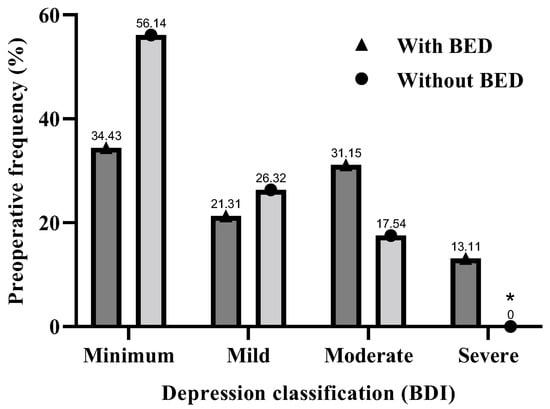
Figure 1
Open AccessArticle
Ability of Hypocaloric Diets to Change Nutrient–Phyla Associations after 8 Weeks of Intervention
by
Natália Yumi Noronha, Luzânia dos Santos Martins, Lígia Moriguchi Watanabe, Marcela Augusta de Souza Pinhel, Guilherme da Silva Rodrigues, Isabelle Mello Schneider, Carolina Ferreira Nicoletti, Heitor Bernardes Pereira Delfino, Daniela Carlos and Carla Barbosa Nonino
Obesities 2024, 4(2), 45-54; https://doi.org/10.3390/obesities4020005 - 26 Mar 2024
Abstract
Background: Previous studies have suggested that changes in the composition of intestinal microbiota may be influenced by dietary quality. Objective: This study aimed to assess the impact of a hypocaloric diet on the relationship between microbiota and clinical/dietary variables. Methods: This was a
[...] Read more.
Background: Previous studies have suggested that changes in the composition of intestinal microbiota may be influenced by dietary quality. Objective: This study aimed to assess the impact of a hypocaloric diet on the relationship between microbiota and clinical/dietary variables. Methods: This was a longitudinal study. Ten women with obesity (Obese Group, ObG) participated in an 8-week home-based hypocaloric diet intervention. Anthropometric, dietary intake, biochemical, and gut microbiota assessments were conducted before and after the intervention. Microbiota relative abundance was determined using real-time PCR in triplicate. Results: In the ObG, the hypocaloric diet intervention led to significant weight loss (before: 119.5 ± 10.3 kg; after: 114.9 ± 10.2 kg; p = 0.003). Following the intervention, positive correlations were observed between nutrient intake and phyla composition: Actinobacteria phylum with fibers (r = 0.787; p = 0.012), Firmicutes phylum with proteins (r = 0.736; p = 0.024), and Proteobacteria phylum with lipids (r = 0.669; p = 0.049). Conclusions: The hypocaloric diet intervention improved health parameters associated with obesity and its comorbidities, demonstrating associations between nutrient intake and specific phyla.
Full article
(This article belongs to the Special Issue How to Prevent Obesity and Inflammatory Disease 2024)
►▼
Show Figures
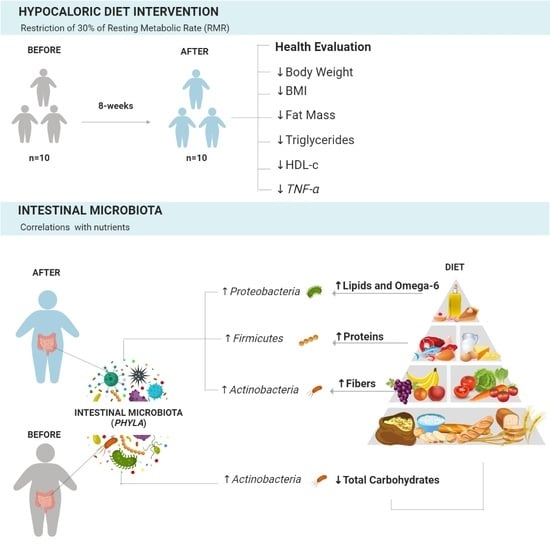
Graphical abstract
Open AccessArticle
Assessment of Body Mass Index, Body Composition, Physical Activity, and Dietary Preferences in University Students: A Pilot Study
by
Karin Petřeková, Nadezhda Borzenko, Martina Kovalová and Nikol Gottfriedová
Obesities 2024, 4(1), 35-44; https://doi.org/10.3390/obesities4010004 - 20 Mar 2024
Abstract
(1) Background: Body composition analysis, particularly the assessment of the amount and distribution of body fat and muscle mass in young people, is of considerable clinical importance for the detection of nutritional disorders. (2) Methods: University students aged 19–25 years had their body
[...] Read more.
(1) Background: Body composition analysis, particularly the assessment of the amount and distribution of body fat and muscle mass in young people, is of considerable clinical importance for the detection of nutritional disorders. (2) Methods: University students aged 19–25 years had their body composition measured using a bioimpedance (BIA) device InBody 370S. Furthermore, a questionnaire survey was performed using the questionnaires: factors that influence your choice of food (FCQ); food preference questionnaire for adolescents and adults (FPQ); the international physical activity questionnaire (IPAQ). (3) Results: Body mass index (BMI) values were within a normal range in 89.5% of men and 77.9% of women, while statistically significant differences between the sexes were confirmed for all body parameters (p < 0.001; p = 0.025). The waist-to-hip ratio (WHR) and percentage body fat (PBF) were abnormally high in 50.4% and 44.3% of women, respectively. High values of skeletal muscle mass (SMM), protein, minerals, and bone mineral content (BMC) were identified in 36.8% of men. A total of 88 students (66.7% of men and women) had a higher level of physical activity, i.e., achieved metabolic equivalent (MET) values of more than 3000 per week. (4) Conclusions: BMI does not always have explanatory power for assessing body weight, as it does not consider the percentage distribution of fat and non-fat body mass in the total body weight. Physical activity and a varied diet have a positive effect on achieving optimal body weight and are effective in preventing nutritional disorders (such as obesity and malnutrition) and associated health problems.
Full article
Open AccessArticle
The Potential Role of Leptin in the Regulation of Maternal Weight during Pregnancy and Its Impact on Neonate Weight and Apgar
by
Daniela G. M. Fonseca, Maria-Carmen N. Souza-Carmo, Raquel N. Ruas, Solange S. Pereira, Lílian Goncalves Teixeira and e Jacqueline I. Alvarez-Leite
Obesities 2024, 4(1), 24-34; https://doi.org/10.3390/obesities4010003 - 07 Mar 2024
Abstract
►▼
Show Figures
Leptin is secreted by adipose tissue and expressed in several organs, including the placenta. We investigated the influence of leptin in maternal blood on leptin expression and concentration in the placenta and umbilical cord and its influence on fetal weight and conditions at
[...] Read more.
Leptin is secreted by adipose tissue and expressed in several organs, including the placenta. We investigated the influence of leptin in maternal blood on leptin expression and concentration in the placenta and umbilical cord and its influence on fetal weight and conditions at the time of birth. Twenty-five parturients were recruited, and after childbirth, placental tissue fragments, umbilical arteries, and vein blood were collected. According to leptin concentration in maternal peripheral blood, parturients were divided into low and high leptin groups. Mothers in the high-leptin group had higher age, pre-pregnancy weight, pre-pregnancy BMI, and weight in late pregnancy than mothers in the low-leptin group. Children of mothers in the high-leptin group presented an Apgar score modestly lower than those of the low-leptin group. No differences were observed in leptin concentrations in the umbilical artery and vein. However, the leptin retained in the fetus increased in the high-leptin group compared to the low-leptin group. We observed a negative correlation between fetal leptin retained and maternal age in the low-leptin group. In the high-leptin group, placental leptin concentration was positively correlated with maternal weight in late pregnancy. Nonetheless, the expression of the leptin receptor (Ob-Rb) was negatively correlated with newborn length. In conclusion, this study found a positive correlation between maternal leptin levels and maternal pre-pregnancy weight, BMI, and fetal birth weight. These findings suggest a potential role of leptin in maternal weight regulation during pregnancy and fetal growth.
Full article

Figure 1
Open AccessArticle
The Double Burden of Malnutrition among Adolescents from Zimbabwe: A Cross-Sectional Study
by
Ashleigh Pencil, Tonderayi Mathew Matsungo, Thomas Mavhu Chuchu, Nobuko Hongu and Naomi Hayami
Obesities 2024, 4(1), 9-23; https://doi.org/10.3390/obesities4010002 - 05 Mar 2024
Abstract
►▼
Show Figures
(1) Background: The double burden of malnutrition (DBM) is an emerging public health concern among children and adolescents in developing countries. This study investigated the prevalence and factors associated with being underweight and overweight among adolescents. (2) Methods: This cross-sectional study was conducted
[...] Read more.
(1) Background: The double burden of malnutrition (DBM) is an emerging public health concern among children and adolescents in developing countries. This study investigated the prevalence and factors associated with being underweight and overweight among adolescents. (2) Methods: This cross-sectional study was conducted among 423 adolescents across 10 high schools in Harare. A questionnaire was used to collect data and weight for height-z-scores were used to compute body mass index. Pearson’s Chi-Square and multinomial logistic regression were used to test for associations and explore factors associated with being underweight or overweight at (p < 0.05). (3) Results: The median and IQR range for the participants was 16 (14–19) years. There were more girls 53.2%, than boys 46.8% (p = 0.002), and more 14–16-year-olds 54.1%, than 17–19-year-olds (p = 0.070). More boys 10% than girls 9.1% were underweight, whereas more girls 21.8% than boys 9.3% were overweight and obese (p = 0.002). By age, more 14–16-year -olds were underweight 12.7% than 17–19-year-olds 5.9%, whereas more 17–19-year-olds 16.2% were overweight than 14–16-year-olds (p = 0.070). Significant factors associated with being underweight were inadequate balanced nutrition knowledge [OR = 1.49 (0.139–0.997), p = 0.049], being in the 14–16 years age group [OR = 2.56 (1.137–5.779), p = 0.023], having formally employed [OR = 2.34 (1.008–5.428), p = 0.048] and unemployed [OR = 5.17 (1.263–21.116), p = 0.022] household heads. Significant factors associated with overweight were being a girl [OR = 0.32 (0.168–2.561), p < 0.001, and having formally employed household heads [OR = 2.00 (1.044–1.206), p = 0.037]. The employment status of the household head (being formally employed) was the only factor which associated with both underweight and overweight statuses. (4) Conclusions: Although underweight and overweight statuses co-exist, among adolescents, those who are overweight appear to be more than those who are underweight. Significant factors associated with being underweight were inadequate nutrition knowledge, being 14–16 years old, and having formally employed or unemployed parents. While being a girl and having formally employed parents were significant determinants of the overweight status. This paper calls for more awareness of DBM and context-specific interventions targeting obesity in a country where undernutrition has been traditionally prioritized at policy and program levels.
Full article

Figure 1
Open AccessBrief Report
Impact of Intensive Lifestyle Intervention on Remission of Metabolic Syndrome, Prediabetes, Diabetes, and Hypertension in Adults Living with Obesity
by
Pierre-Olivier Magnan, Josep Iglesies-Grau, Élise Latour, Valérie Guilbeault, Anil Nigam, Martin Juneau, Louis Bherer and Mathieu Gayda
Obesities 2024, 4(1), 1-8; https://doi.org/10.3390/obesities4010001 - 26 Feb 2024
Abstract
►▼
Show Figures
Background: Lifestyle intervention programs have long been shown to be effective in preventing cardiometabolic risk factors (CMRFs) such as metabolic syndrome (MS), impaired fasting glycaemia (IFG), type II diabetes (T2DM), and hypertension (HTA). However, their potential for remission of these CMRFs in overweight/obese
[...] Read more.
Background: Lifestyle intervention programs have long been shown to be effective in preventing cardiometabolic risk factors (CMRFs) such as metabolic syndrome (MS), impaired fasting glycaemia (IFG), type II diabetes (T2DM), and hypertension (HTA). However, their potential for remission of these CMRFs in overweight/obese adults is less clear. The importance of attaining remission has significantly increased as these CMRFs are more and more prevalent. Objectives: The aim of this study is to determine the impact of an intensive lifestyle intervention program on the remission of MS, IFG, T2DM, and HTA in overweight/obese adults. Methods: Forty participants living with overweight/obesity were enrolled in an 18-month multidisciplinary primary prevention body mass loss intervention program. MS, IFG, T2DM, and HTA statuses were assessed at baseline, 9 months, and the end of the program. Results: At baseline, 25 participants (64.1%) had MS, 7 (17.9%) had IFG, 4 (10.2%) were living with diabetes, and 28 (70.0%) had HTA. At 18 months, six (24%) of the participants living with MS, two (28.6%) of the participants with IFG, two (50%) of the participants with diabetes, and two (7.1%) of the participants with HTA met all criteria for remission. Conclusion: An intensive lifestyle intervention program consisting of monitored exercise training and lifestyle modification counselling has great potential for achieving remission of CMRFs in adults living with overweight/obesity.
Full article

Figure 1
Open AccessReview
Gut Microbiota and Obesity: The Chicken or the Egg?
by
Daniele S. Tassoni, Rodrigo C. O. Macedo, Felipe M. Delpino and Heitor O. Santos
Obesities 2023, 3(4), 296-321; https://doi.org/10.3390/obesities3040024 - 27 Nov 2023
Cited by 1
Abstract
►▼
Show Figures
Although the link between gut microbiota and obesity is increasingly reported, the pathophysiological mechanisms and clinical outcomes are still under debate. This overview of human and animal data addresses several pathophysiologic mechanisms, dietary habits, exercise and probiotic and symbiotic supplementation in the fields
[...] Read more.
Although the link between gut microbiota and obesity is increasingly reported, the pathophysiological mechanisms and clinical outcomes are still under debate. This overview of human and animal data addresses several pathophysiologic mechanisms, dietary habits, exercise and probiotic and symbiotic supplementation in the fields of gut microbiota and obesity. Overall, obesity impairs gut microbiota composition due to factors that may be linked to the onset of the disease, such as excessive consumption of high-energy foods, sugars and fats, as well as a low fiber intake and physical inactivity. Conversely, low-energy diets, physical exercise, and probiotic and prebiotic supplementations can enhance gut microbiota in patients with obesity, in addition to improving cardiometabolic markers. As for perspectives, further research is warranted to ascertain proper dietary manipulation, physical exercise protocols and dosing regimens of probiotics. Regarding the latter, the effects on indicators of obesity are clinically modest, and hence skepticism must be exercised.
Full article
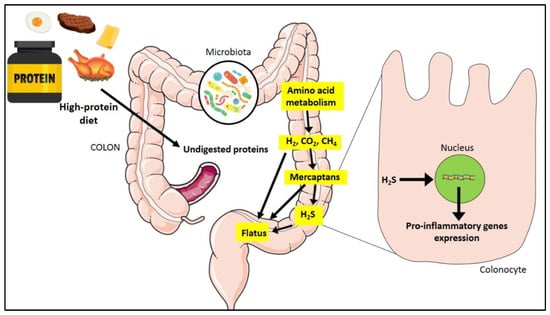
Figure 1
Open AccessArticle
Exploring Factors Associated with Gender Differences in Perceived Stress among Adults with Higher Body Weight in the United States—A Cross-Sectional Analysis
by
Nadeeja N. Wijayatunga, Joseph D. Wellman and Kevin Tomasko
Obesities 2023, 3(4), 287-295; https://doi.org/10.3390/obesities3040023 - 27 Nov 2023
Abstract
►▼
Show Figures
This study aimed to explore factors associated with perceived stress in adults with higher body sizes. An analysis of data from participants who self-reported higher body weight was conducted (n = 1716). The mean (standard deviation) age was 55.92 (15.94) years and 71.3%
[...] Read more.
This study aimed to explore factors associated with perceived stress in adults with higher body sizes. An analysis of data from participants who self-reported higher body weight was conducted (n = 1716). The mean (standard deviation) age was 55.92 (15.94) years and 71.3% and 28.7% identified themselves as women and men, respectively. Gender differences in perceived stress, desire for weight loss, trust in physicians, body affirmation, and perceived weight discrimination were examined. Perceived stress and perceived weight discrimination were significantly higher in women than in men, while trust in physicians and body affirmation was higher in men than women. Trust in physicians and body affirmation were both negatively associated with perceived stress. Perceived weight discrimination and desire for weight loss were both positively associated with perceived stress. Trust in physicians, body affirmation, and perceived weight discrimination were examined as mediators of the observed gender differences between men and women. Trust in physicians, body affirmation, and perceived weight discrimination were significant mediators of the relationship between gender and perceived stress. These results suggest that a possible point of intervention for addressing gender differences in rates of perceived stress among higher body weight adults may be to increase trust in physicians, encourage body affirmation, and reduce weight discrimination.
Full article
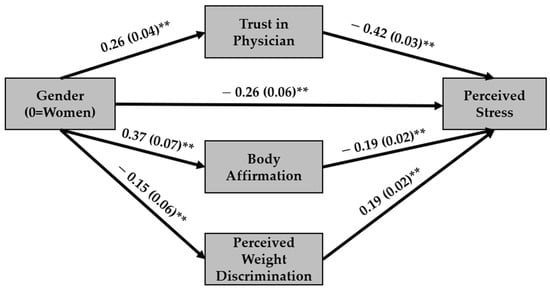
Figure 1
Open AccessArticle
Effects of Sulforaphane and Chlorophyl a in a Western Diet-Induced Obesity Model
by
Tânia Martins, Ana Filipa Matos, Joana Soares, Rúben Leite, Maria João Pires, Maria de Lurdes Pinto, Maria João Neuparth, Sandra Mariza Monteiro, Ana Rita Sequeira, Luís Félix, Carlos Venâncio, Eduardo Rosa, Paula Alexandra Oliveira and Luís Miguel Antunes
Obesities 2023, 3(4), 265-286; https://doi.org/10.3390/obesities3040022 - 17 Nov 2023
Abstract
►▼
Show Figures
The global rise in obesity and its co-morbidities raises worldwide health, social and economic concerns, especially in developed countries. Compounds derived from natural sources are now in the focus of pharmacological therapies. In recent years, sulforaphane (SFN) has been the subject of studies
[...] Read more.
The global rise in obesity and its co-morbidities raises worldwide health, social and economic concerns, especially in developed countries. Compounds derived from natural sources are now in the focus of pharmacological therapies. In recent years, sulforaphane (SFN) has been the subject of studies due to its anti-cancer, anti-inflammatory, antioxidant and potential anti-obesity effects. Lately, some studies have also reported the anti-obesogenic potential of chlorophyll. In this study, we evaluated the anti-obesity effects of SFN and chlorophyll a (Chlo.a) in C57BL/6J mice fed with a Western diet, rich in sugar and fat. The study lasted 14 weeks, and for the last 4 weeks SFN (0.25 or 0.5 mg/kg/day) or Chlo.a (0.2 or 0.5 mg/kg/day) was administered orally. The results showed that supplementation with SFN or Chlo.a resulted in an increase in body temperature and a reduction in the size of adipocytes. However, the administration of SFN or Chlo.a for 4 weeks did not decrease the body weight gain or hepatic steatosis, and increased hepatic ROS counterbalancing with an increase in SOD activity. In conclusion, in the animal model used, treatment with SFN or Chlo.a did not show strong anti-obesity effects; however, slight improvements were observed with the supplementation of these compounds.
Full article
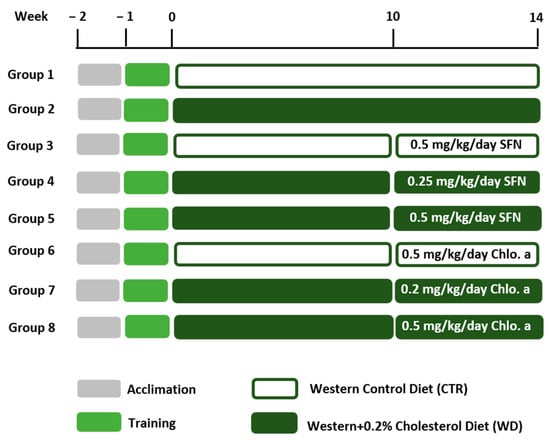
Figure 1
Open AccessArticle
Gut Microbiota Profiles of Children with Obesity or Metabolic Syndrome: Body Mass Index Is a Lead Actor
by
Grace N. Gathungu, Daniel N. Frank, Anupama Chawla, Charles E. Robertson, Joseph F. LaComb, Katherine Markarian, Brianna M. Burghard and Robert Woroniecki
Obesities 2023, 3(3), 253-264; https://doi.org/10.3390/obesities3030021 - 14 Sep 2023
Abstract
►▼
Show Figures
The worldwide prevalence of obesity and associated metabolic syndrome (MetS) has increased threefold over the last five decades. Among children, this trend is alarming due to the premature onset of MetS. The data regarding how the structure and composition of gastrointestinal (GIT) microbiota
[...] Read more.
The worldwide prevalence of obesity and associated metabolic syndrome (MetS) has increased threefold over the last five decades. Among children, this trend is alarming due to the premature onset of MetS. The data regarding how the structure and composition of gastrointestinal (GIT) microbiota either promote or attenuate obesity and MetS are limited. Objectives: We carried out this study to investigate the relationship between microbial profiles and diagnosis of MetS among children with obesity. Fifty subjects with a diagnosis of obesity or Mets were enrolled. We collected clinical information, demographic data, dietary records, and stool specimens. Overall, there was no significant difference in the diversity of GIT microbiota between the two subgroups of children with obesity or MetS. We also found no differences in the diversity of GIT microbiota between the sexes and blood pressure categories. However, we observed a significant difference between the structure, composition, and diversity of the gut microbiome when the subjects were stratified using a BMI cut-off of 30. Subjects with a BMI ≥ 30 had a lower abundance of Bacteroidetes and a greater abundance of Actinobacteria and Firmicutes compared to those with a BMI value of less than 30. This gut microbiota signature is more like the GIT microbiome profile of adults with obesity and may represent accelerated changes among children. Additional studies are needed to investigate the role of obesity in the maturation of gut microbiota in children with morbid obesity.
Full article

Figure 1
Open AccessReview
The Roles of MicroRNAs in Obesity: Emphasizing Links with Chronic Kidney Disease and Cardiovascular Disorders
by
Valérie Metzinger-Le Meuth and Laurent Metzinger
Obesities 2023, 3(3), 243-252; https://doi.org/10.3390/obesities3030020 - 13 Sep 2023
Abstract
Obesity has become a global epidemic, contributing to the development of numerous chronic diseases, including diabetes, chronic kidney disease (CKD) and cardiovascular disorders. MicroRNAs (miRNAs) have emerged as key regulators in various biological processes, including metabolism, inflammation, and tissue remodeling, making them pivotal
[...] Read more.
Obesity has become a global epidemic, contributing to the development of numerous chronic diseases, including diabetes, chronic kidney disease (CKD) and cardiovascular disorders. MicroRNAs (miRNAs) have emerged as key regulators in various biological processes, including metabolism, inflammation, and tissue remodeling, making them pivotal players in obesity-related pathologies. This review aims to provide comprehensive insights into the roles of miRNAs in obesity, with a particular emphasis on their involvement in the pathogenesis of CKD and cardiovascular disorders. We highlight the involvement of specific miRNAs in adipose tissue development, energy homeostasis, inflammation, and insulin resistance, contributing to the pathogenesis of obesity. Moreover, we explore the impact of miRNAs on renal fibrosis and inflammation, giving clues on their roles in the development and progression of CKD. Additionally, we discuss the influence of miRNAs on endothelial dysfunction, atherosclerosis, and cardiac remodeling, emphasizing their contribution to obesity-related cardiovascular disorders. Understanding the regulatory functions of miRNAs in these interconnected conditions holds promise for improved diagnosis, prognosis, and therapeutic interventions. Indeed, miRNAs are potential diagnostic biomarkers for obesity-related diseases, although challenges remain to be elucidated before their clinical translation. Furthermore, we highlight the emerging strategies that target miRNAs as therapeutic interventions to mitigate the detrimental effects of obesity on kidney and cardiovascular health.
Full article
(This article belongs to the Topic Metabolism and Health)
►▼
Show Figures

Figure 1
Open AccessArticle
Metabolic Profile of Liver Transplant Recipients and Determinants of their Body Fat Distribution
by
Kinga Czarnecka, Paulina Czarnecka, Olga Tronina, Teresa Bączkowska, Anna Jagielska and Magdalena Durlik
Obesities 2023, 3(3), 225-242; https://doi.org/10.3390/obesities3030019 - 25 Aug 2023
Abstract
Obesity and diabetes mellitus epidemics exert a measurable impact on the liver transplant (Ltx) population. This study aimed to investigate the metabolic profile of Ltx recipients and its association with body fat distribution. Adults who underwent de novo elective cadaveric-donor Ltx were eligible.
[...] Read more.
Obesity and diabetes mellitus epidemics exert a measurable impact on the liver transplant (Ltx) population. This study aimed to investigate the metabolic profile of Ltx recipients and its association with body fat distribution. Adults who underwent de novo elective cadaveric-donor Ltx were eligible. Metabolic syndrome (MS) was diagnosed based on the adapted International Diabetes Federation, the American Heart Association, and the National Heart, Lung, and Blood Institute guidelines. We recruited 100 patients with a mean age of 54 years, of whom 70% were men. Overall, 54% met the criteria for MS, most of which comprised new-onset cases. Excessive fat accumulation in liver donors was found to be associated with an increased metabolic risk in liver recipients. Haemoglobin A1C (OR: 8.962, 95% CI: 2.188–84.545, p = 0.013), ferritin (OR: 1.024, 95% CI: 1.005–1.054, p = 0.038), and de novo hypertriglycaeridemia (OR 27.957, 95% CI: 2.626–752.121, p = 0.014) were found to be independently associated with de novo MS. After a step-wise multivariate analysis, only the anthropometric obesity indices were significantly associated with abdominal fat distribution in Ltx recipients. Metabolic complications were common in liver recipients. Both pre- and post-Ltx factors impacted MS development in liver recipients and determined abdominal fat distribution.
Full article
(This article belongs to the Topic Metabolism and Health)
►▼
Show Figures
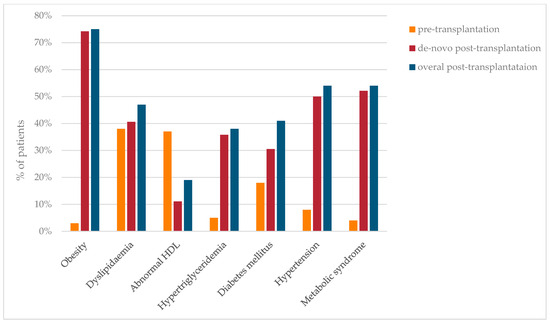
Figure 1
Open AccessReview
Time-Restricted Feeding and Weight Loss in Obesity: A Mini Review on the Impacts on Skeletal Muscle Mass
by
Guilherme Correia Ferri Antonio, Adelino Sanchez Ramos da Silva, Ellen Cristini De Freitas and José Rodrigo Pauli
Obesities 2023, 3(3), 218-224; https://doi.org/10.3390/obesities3030018 - 02 Aug 2023
Cited by 1
Abstract
►▼
Show Figures
Across the globe, obesity is a significant concern for public health, a disease characterized by excessive accumulation of body fat, with a negative impact on health. Time-restricted feeding (TRF), in which food accessibility is restricted to a variable period of 8–10 h, especially
[...] Read more.
Across the globe, obesity is a significant concern for public health, a disease characterized by excessive accumulation of body fat, with a negative impact on health. Time-restricted feeding (TRF), in which food accessibility is restricted to a variable period of 8–10 h, especially in the active phase, inducing a prolonged fasting period, is a strategy with potential effects in preventing obesity. Evidence in preclinical studies demonstrated that TRF attenuates the impacts of metabolic disturbances related to high-fat diet feeding in rodents. Through these discoveries, there has been growing interest in revealing the effects associated with TRF in preventing obesity and its comorbidities, as well as investigating its effects in humans. Although TRF is a promising alternative to reduce the impact of obesity, it is necessary to investigate the results on skeletal muscle tissue. Muscle tissue is important for body energy expenditure; however, caloric restriction can negatively impact protein turnover and induce loss of muscle mass, influencing the basal metabolic rate and weight loss. This mini review examined the scientific literature exploring the effects of time-restricted feeding (TRF) on muscle mass. Although still incipient, the findings related to TRF applied to obese individuals highlight the importance of carrying out dietary control, as well as the consumption and fractionation of proteins, to maintain a balanced protein turnover and, consequently, muscle mass.
Full article
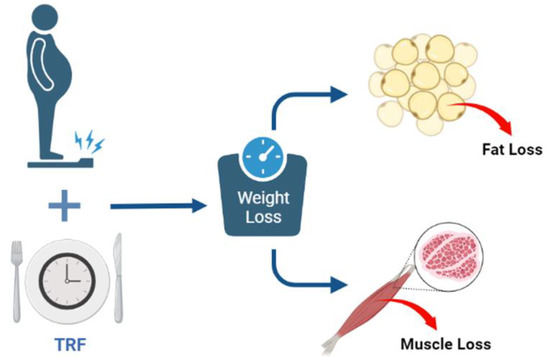
Figure 1
Open AccessCase Report
Eating Causes Clinically Significant Distress: Food Addiction as a Disordered Belief in Anorexia Nervosa?
by
Jônatas de Oliveira
Obesities 2023, 3(3), 207-217; https://doi.org/10.3390/obesities3030017 - 07 Jul 2023
Abstract
Anorexia nervosa (AN) is characterized by an intense fear of weight gain, dietary restriction resulting in a significant weight loss compared with what is expected, and a disturbance in body image on a psychological basis. Recently, cases of AN associated with food addiction
[...] Read more.
Anorexia nervosa (AN) is characterized by an intense fear of weight gain, dietary restriction resulting in a significant weight loss compared with what is expected, and a disturbance in body image on a psychological basis. Recently, cases of AN associated with food addiction (FA) were described in almost all patients (69%), bringing a controversial aspect to the restrictive subtype (AN-r) that, in theory, even in the absence of binge eating, would present difficulties regarding control. Objectives: To report a case of an adolescent with AN-r associated with FA. Methods: Clinical history, current status, psychiatric diagnosis, and scores on scales to assess FA, food craving, and binge eating were analyzed. Results: This case report emphasizes the importance of new diagnostic tools to identify FA and whether it exists in people with AN-r beyond distress regarding eating behavior, cravings, and guilt. Eating behavior also presents a negative value that delays the elaboration process and the emergence of food cravings. In addition, an analysis of the association between the diagnostic criteria for substance use disorder, binge eating disorder, anorexia nervosa, and bulimia nervosa with the Yale Food Addiction Scale statements and criteria was discovered. Conclusions: Based on the characteristics of AN, emotional dysregulation and eating difficulties seem to overlap with FA symptoms.
Full article
Open AccessReview
Green Tea Induces the Browning of Adipose Tissue—Systematic Review
by
Ana Paula Azevêdo Macêdo, Mariane dos Santos Gonçalves, Jairza Maria Barreto-Medeiros, Oscar Caetano da Silva Neto, Jorge Mauricio David, Cristiane Flora Villarreal, Simone Garcia Macambira, Milena Botelho Pereira Soares and Ricardo David Couto
Obesities 2023, 3(3), 193-206; https://doi.org/10.3390/obesities3030016 - 22 Jun 2023
Cited by 2
Abstract
►▼
Show Figures
Several foods and nutrients are being studied extensively because they have a positive effect on thermogenesis and the browning of white adipose tissue. Therefore, this study aims to evaluate, through a systematic review, the effect of green tea for inducing browning of adipose
[...] Read more.
Several foods and nutrients are being studied extensively because they have a positive effect on thermogenesis and the browning of white adipose tissue. Therefore, this study aims to evaluate, through a systematic review, the effect of green tea for inducing browning of adipose tissue. The systematic review was built following the recommendations of the Preferred Reporting Items for Systematic Reviews and Meta-Analyze. We searched the following electronic databases: PubMed (Medline), Science Direct, Scopus, and Web of Science. We included ten experimental articles that used green tea to treat induced obesity in rodents. Green tea reduced the weight of white and brown adipose tissue, positively regulated gene expression and microRNA that regulate the metabolism of adipose tissue, and morphological changes were identified as beige tissue. According to the results found, the factors involved in this induction to browning are PPARγ, PGC-1α, UCP1, CPT, and PRDM16. Therefore, green tea promotes the browning of adipose tissue in rodents. It is important to emphasize the need for studies in obese humans to identify whether the same metabolic response occurs.
Full article
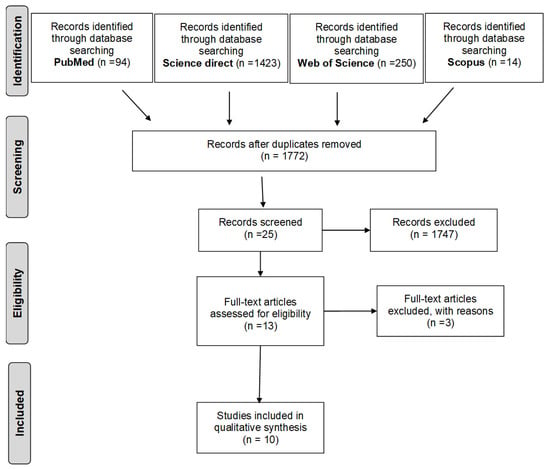
Figure 1
Open AccessArticle
Intermittent Energy Restriction Combined with a High-Protein/Low-Protein Diet: Effects on Body Weight, Satiety, and Inflammation: A Pilot Study
by
Nada Eid Alzhrani and Jo M. Bryant
Obesities 2023, 3(2), 180-192; https://doi.org/10.3390/obesities3020015 - 19 May 2023
Abstract
Intermittent energy restricted (IER) diets have become popular as a body weight management approach. In this pilot study, we investigated if an IER diet would reduce systemic inflammation and if maintaining an elevated protein level while on an IER diet would enhance satiety.
[...] Read more.
Intermittent energy restricted (IER) diets have become popular as a body weight management approach. In this pilot study, we investigated if an IER diet would reduce systemic inflammation and if maintaining an elevated protein level while on an IER diet would enhance satiety. Six healthy women, aged 33–55 years with a BMI of 27–33 kg/m2, were randomized to first adhere to either a low- or high-protein IER diet using whole foods for three weeks. They then returned to their regular diets for a week, after which they adhered to the second diet for three weeks. Each test diet consisted of three low-energy intake days followed by four isocaloric energy intake days. The diets differed only in protein content. High-sensitivity C-reactive protein (hs-CRP), glucose, satiety, body weight, and waist circumference were measured at the beginning and end of each dietary intervention. Most participants showed reductions in hs-CRP levels from baseline on both IER diets but reported greater satiety when adhering to the higher protein IER diet. Overall, the IER diets reduced body weight and appeared to decrease inflammation in these overweight women, and the higher protein version enhanced satiety, which may lead to greater long-term dietary adherence.
Full article
(This article belongs to the Special Issue How to Prevent Obesity and Inflammatory Disease 2022)
►▼
Show Figures
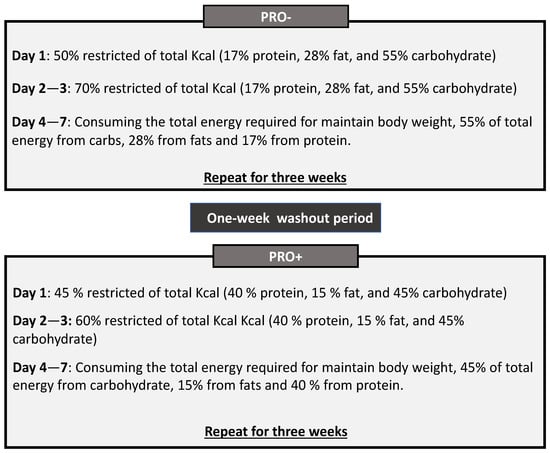
Figure 1
Open AccessArticle
Obesity and Residents’ Perceptions of Their Neighborhood’s Urban Amenities and Ambient Environment
by
Rayman Mohamed and Bengt Arnetz
Obesities 2023, 3(2), 165-179; https://doi.org/10.3390/obesities3020014 - 18 May 2023
Abstract
►▼
Show Figures
There is a lack of research on how perceptions about urban spaces are associated with obesity. We surveyed 347 residents in a rapidly changing area of Detroit, Michigan about their perceptions of urban amenities and the ambient environment. We use principal component analysis
[...] Read more.
There is a lack of research on how perceptions about urban spaces are associated with obesity. We surveyed 347 residents in a rapidly changing area of Detroit, Michigan about their perceptions of urban amenities and the ambient environment. We use principal component analysis to reduce the urban amenity and ambient environment variables to a manageable number. We use a spatial error model to account for spatial autocorrelation. We find that more urban amenities are associated with decreased obesity. A one-percent increase in residents’ perceptions of the availability of urban amenities is associated with a 0.13 percent decrease in obesity. Adverse ambient environments are associated with increased obesity. A one-percent increase in residents’ perceptions of adverse ambient environment quality is associated with a 0.12-percent increase in obesity. Addressing residents’ perceptions about urban spaces can provide planners with an additional tool to tackle obesity.
Full article
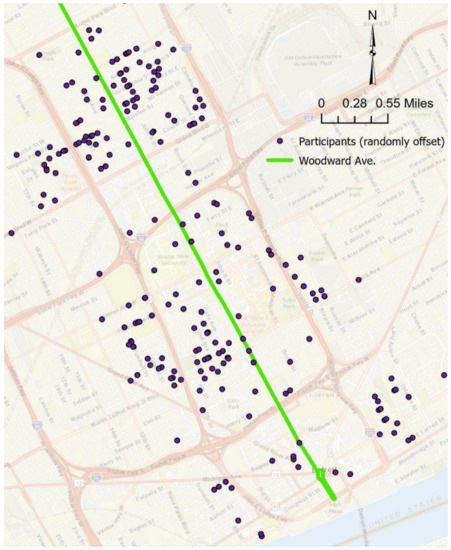
Figure 1
Open AccessArticle
Respiratory Muscle Strength in Brazilian Adolescents: Impact of Body Composition
by
Viviane Campos de Lima, Marcelo Luis Marquezi, Paulo Roberto Alcantara, Nayara Barbosa Lopes, Caroline Santana Frientes, Thais Miriã da Silva Santos, Leonardo Ribeiro Miedes, Matheus Silva Fornel, Danielle Castro Oliveira, Patrícia Soares Rogeri, Antônio Herbert Lancha Junior, Nathalia Bernardes and Juliana Monique Lino Aparecido
Obesities 2023, 3(2), 155-164; https://doi.org/10.3390/obesities3020013 - 15 May 2023
Abstract
►▼
Show Figures
(1) Introduction: Studies on respiratory muscle strength (RMS) in adolescents are controversial. Few studies so far have investigated respiratory muscle strength in Brazilian adolescents and the impact of body composition on it. (2) Objective: to evaluate the respiratory muscle strength of Brazilian adolescents
[...] Read more.
(1) Introduction: Studies on respiratory muscle strength (RMS) in adolescents are controversial. Few studies so far have investigated respiratory muscle strength in Brazilian adolescents and the impact of body composition on it. (2) Objective: to evaluate the respiratory muscle strength of Brazilian adolescents and compare this with nationally and internationally predicted normality values. (3) Method: A cross-sectional study (CAEE: 34634414.5.0000.5479) was carried out with 98 adolescents, where both sexes were divided into four groups: eutrophic (n = 44); overweight (n = 15), obese (n = 25), and severely obese (n = 14). All were submitted to an anthropometric assessment, body composition analysis and manovacuometry. To interpret the results, Analysis of Variance (ANOVA) with Turkey’s post hoc test was used. The Kruskal–Wallis test and Friedman’s post hoc test were used to compare the observed vs. proposed results. A p-value < 0.05 was considered statistically significant. (4) Results: There were no differences among the groups for maximal inspiratory (MIP) and expiratory (MEP) pressures. However, when considering the total sample, we could say that RMS was higher among boys, and there were no significant differences in RMS in relation to the maturational stage. The values obtained for MIP were lower than those suggested for the national equation and higher than those proposed for the international equation. Similarly, the values obtained for MEP were lower than those suggested for the national and international equation. (5) Conclusions: RMS was similar in adolescents with different body compositions and different maturation stages. Adiposity did not interfere with RMS in adolescents. Boys had higher MIP and MEP values compared to girls. Therefore, the reference values proposed by the equations do not consistently match RMS in the adolescents studied. This context reinforces the need for new studies that are related to RMS to establish normality values and propose equations that represent the youth population.
Full article
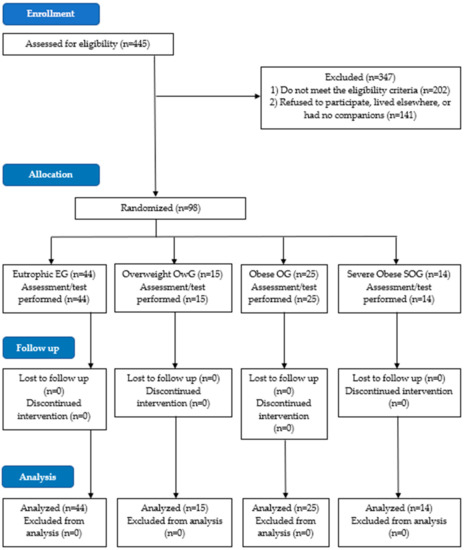
Figure 1
Highly Accessed Articles
Latest Books
E-Mail Alert
News
Topics

Conferences
Special Issues
Special Issue in
Obesities
How to Prevent Obesity and Inflammatory Disease 2024
Guest Editor: Sara BaldassanoDeadline: 31 October 2024

